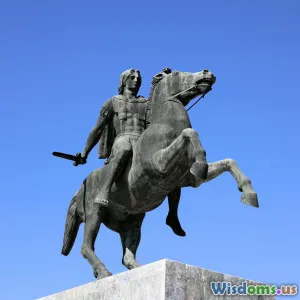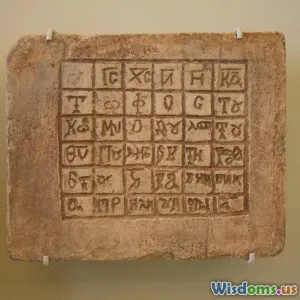
Alexander the Great’s Fastest Victories and Their True Costs
9 min read Explore Alexander the Great's swift military triumphs and the profound consequences that accompanied his rapid conquests. (0 Reviews)
Alexander the Great’s Fastest Victories and Their True Costs
Alexander the Great remains one of history’s most remarkable military geniuses, renowned for a whirlwind of victories that constructed a vast empire stretching from Greece to India within a decade. His ability to obliterate enemies swiftly and decisively has inspired countless generations, leading to his immortal status. Yet, behind these dazzling military feats lurk profound and complex costs. The rapid pace of his victories came at a human, political, and cultural price that shaped—and often destabilized—the regions he conquered. This article will journey through Alexander’s fastest victories, exploring their tactics, outcomes, and true costs to better understand the legacy he etched across continents.
The Prologue: Setting the Stage for Swift Conquests
Alexander inherited Macedonia’s throne at just 20 years old in 336 BCE, already commanding a seasoned army molded by his father, Philip II. Despite his youth, he possessed both the education courtesy of Aristotle and the ambition fueled by the dual legacy of Achilles and Heracles. Amidst this backdrop, Alexander swiftly embarked on campaigns designed to crush Persian dominance and spread Hellenistic culture.
His early maneuvers demanded rapid mobility, crucial to his hallmark lightning warfare. But while speed brought dazzling victories, it also magnified logistical difficulties and socio-political challenges. Before detailing specific battles, it’s vital to appreciate the military strategies underpinning his swift successes:
-
Companion Cavalry and Phalanx Coordination: Alexander’s elite cavalry units — notably the Companion Cavalry — specialized in shock tactics complemented by the dense, disciplined Macedonian phalanx.
-
Surprise and Psychological Warfare: Rapid, unexpected strikes often dismantled enemy morale and cohesion swiftly.
-
Engineering and Logistics: Swift sieges and adaptive logistic support enabled quick follow-through after battlefield success.
Blitzkrieg at Granicus: The Opening Salvo
Victory in Hours, Impact for Decades
In 334 BCE, Alexander crossed into Asia Minor, facing the Persian satraps at the Battle of Granicus River. Despite being outnumbered, his army maneuvered boldly, launching a cavalry charge across the river against a well-positioned enemy.
This battle, won within hours, was more than a tactical triumph— it served as a psychological bootcamp for the Macedonian troops and marked the collapse of Persian control over Anatolia.
Costs:
-
Heavy Casualties: While victorious, Alexander's forces suffered significant losses, including many Companion Cavalrymen, temporary weakening his elite units.
-
Local Resistance: The brutal aftermath, including executions of surrendered soldiers and loyal satraps, provoked resentment in local populations.
-
Political Vacuum: The hasty power shift destabilized regional governance, causing pockets of rebellions and unrest that demanded constant suppression.
Siege of Tyre: Seven-Month Ordeal in the Midst of Speed
Although Alexander’s campaigns were noted for rapid conquests, the seven-month siege of Tyre (332 BCE) is a glaring exception demonstrating the limits and costs of rapid expansion.
Strategic Importance
Tyre, an island fortress city, boasted formidable defenses and Persian allegiance. Its capture was critical to secure the eastern Mediterranean coastline, vital for supply routes and preventing Persian naval dominance.
True Costs of This Protracted Victory:
-
Resource Drain: Despite unwavering determination, the siege cost Alexander time, manpower, and resources possibly better used elsewhere.
-
High Casualties and Atrocities: Following its fall, Alexander ordered mass executions and enslaved thousands, eliciting international horror and sowing deep-seated enmity.
-
Psychological Toll: The experience challenged Alexander’s invincibility image, reminding both allies and enemies of potential vulnerabilities.
Battle of Issus: Speed Meets Surprise
Few battles illustrate Alexander’s swiftness and military acumen better than the Battle of Issus in 333 BCE. Despite facing Darius III’s vastly larger army, Alexander’s intimate knowledge of terrain and rapid decision-making turned the tide.
His victory shattered Persian morale and forced Darius into frantic retreats that left territories ripe for Macedonian takeover.
Costs:
-
Displacement of Civilians: Rapid influx of Macedonian forces into conquered cities incurred urban upheaval and refugee crises.
-
Governance Challenges: Fast territorial gains outpaced political consolidation, forcing Alexander to install satraps and military governors who sometimes ruled with iron fists.
-
Economic Strain: The destruction and plundering, though enriching Alexander’s treasury, disrupted local economies, often taking years to recover.
The Indian Campaign: Rapid Expansion at the Fringe
Alexander's venture into India, beginning with the Battle of the Hydaspes in 326 BCE, represented his fastest and most costly forwardly push.
Facing King Porus, Alexander’s well-coordinated river crossing and cavalry assault secured a tough victory, but one that tested his army’s endurance.
Significant Costs:
-
Mutiny and Exhaustion: Years of campaigning took a toll; Alexander’s troops famously mutinied when pressured to march further east after Hydaspes.
-
Cultural Clash: Integrating Indian troops and embracing local customs challenged the Macedonian norms, causing friction among his command.
-
Human Price: The battle exacted heavy losses for both sides; some estimates suggest that tens of thousands died or were wounded.
The Unseen Costs: Cultural and Political Repercussions
Hellenistic Fusion or Forced Assimilation?
Alexander’s rapid conquests were not purely military campaigns — culturally, they aimed to merge Greek and Eastern elements. His city-building programs (founding of Alexandria in Egypt, for example) and encouragement of intermarriage sought to create unity.
Yet this fusion had mixed results:
-
Some regions embraced Hellenistic culture, leading to vibrant new artistic and philosophical schools.
-
Others resisted, with forced Greek dominance igniting unrest.
-
Subsequent Diadochi wars, sparked by power vacuums after Alexander's death, fractured the empire vastly.
Economic Implications
The spoils of war filled Macedonian coffers, but rapid conquest often destabilized local economies with sudden changes in taxation, forced labor for construction, and violent suppression of dissent.
Legacy and Memory
Alexander’s fast victories carved an enduring legacy of both heroism and tragedy. Greek and Roman historians marveled at his brilliance, while indigenous narratives mourned the devastation and cultural losses.
Conclusion: Triumph and Turmoil Intertwined
Alexander the Great’s swift victories remain a testament to his tactical genius and bold leadership. From Granicus’ surprise charge to the taxing triumph at Tyre, each conquest combined incredible speed with heavy burdens. The costs ranged from human casualties and cultural upheaval to political instability that resurfaced for centuries.
Understanding Alexander’s successes requires grappling not only with his brilliance on the battlefield but also with the enduring price paid by millions. His legacy is a mosaic etched with quick glory and lasting challenges — a reminder that swift conquest often exacts profound costs beneath its victorious veneer.
As modern leaders and strategists study Alexander, they find not only inspiration but also cautionary lessons about the true costs of rapid expansions. His story urges us to weigh speed against sustainability, triumph against human toll, and glory against the resilience of the civilizations we touch.
Rate the Post
User Reviews
Popular Posts

















